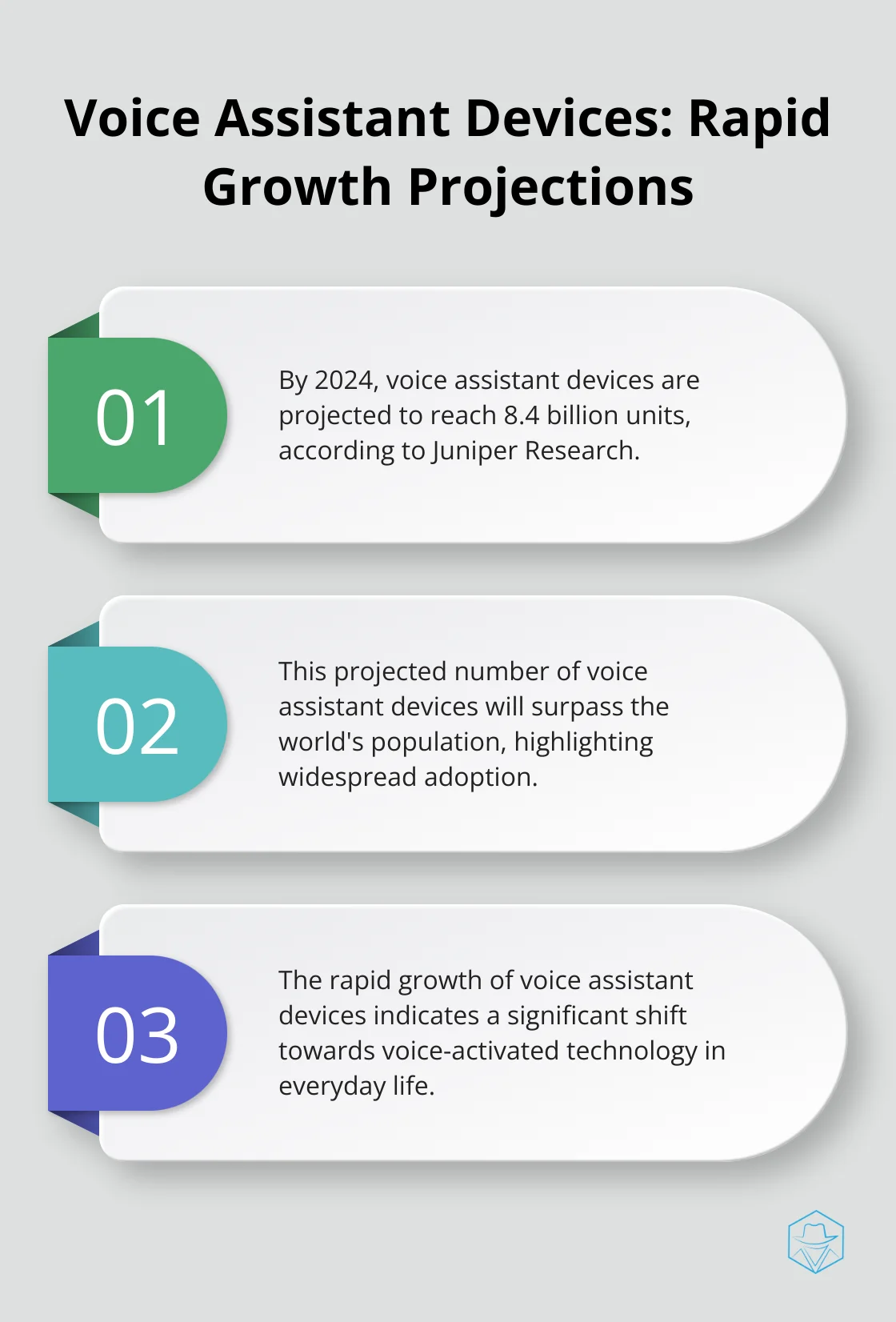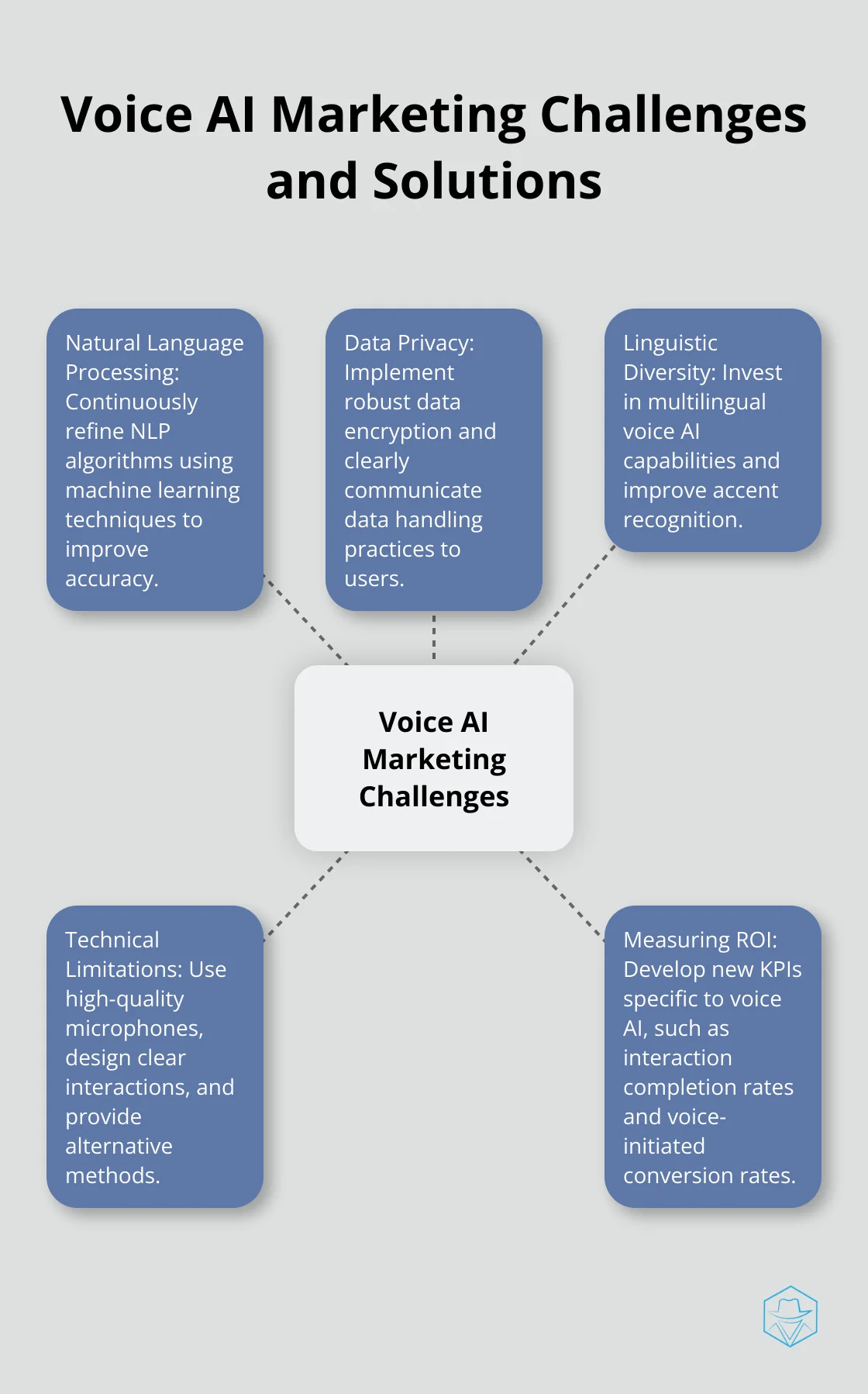Voice AI Applications in Modern Marketing Strategies

Voice AI is revolutionizing the marketing landscape, transforming how businesses connect with their customers. At Drop Cowboy, we’ve witnessed firsthand the power of this technology to create more engaging and personalized experiences.
From voice-activated devices to virtual assistants, the rise of voice interactions is reshaping consumer behavior and marketing strategies. In this post, we’ll explore innovative Voice AI applications, tackle common challenges, and provide insights on effectively integrating this technology into your marketing efforts.
How Voice AI Reshapes Marketing
The Voice-First Revolution
Voice AI transforms the marketing landscape, and Drop Cowboy stands at the forefront of this revolution. The proliferation of voice-activated devices and virtual assistants has exploded in recent years, with smart speakers becoming a household staple. A report by Juniper Research projects the number of voice assistant devices in use will reach 8.4 billion by 2024 (surpassing the world’s population).
Shifting Consumer Behavior
This surge in voice technology adoption leads to a significant shift in consumer behavior. People now use voice commands for everyday tasks, from setting reminders to making purchases. A PwC study found that 71% of consumers prefer to use voice assistants for searches rather than typing. This trend reshapes how marketers approach customer interactions and campaign strategies.

Voice Search Optimization
The rise of voice search impacts search engine optimization (SEO) and content strategies profoundly. Unlike traditional text-based searches, voice queries tend to be longer and more conversational. Marketers must adapt their SEO tactics to target natural language phrases and question-based queries.
Content Creation for Voice
To capitalize on this trend, businesses should focus on creating content that answers specific questions and provides concise, valuable information. FAQ pages, how-to guides, and location-based content become increasingly important in voice search optimization. Marketers should consider the context in which voice searches are made (often on-the-go or hands-free situations) and tailor their content accordingly.
Engagement and Satisfaction
Businesses that leverage voice AI in their marketing strategies often see higher engagement rates and improved customer satisfaction. Companies can stay ahead of the curve and create more meaningful connections with their audience by embracing this technology and adapting to the voice-first consumer landscape.
As we move forward, it’s clear that voice AI applications in marketing strategies will continue to evolve and expand. Let’s explore some innovative ways marketers are using this technology to create personalized and engaging customer experiences.
How Voice AI Transforms Your Marketing
Creating Hyper-Personalized Customer Experiences
Voice AI offers unprecedented opportunities for personalization in marketing. This technology analyzes speech patterns, tone, and context to tailor responses to individual customers in real-time. A clothing retailer could use Voice AI to recommend outfits based on a customer’s verbal style preferences. This level of personalization leads to higher conversion rates and customer satisfaction.
A study by Accenture found that 91% of consumers prefer to shop with brands that recognize, remember, and provide relevant offers and recommendations. Voice AI makes this possible at scale.

Revolutionizing Customer Service with AI-Powered Assistants
Voice-activated chatbots and virtual assistants transform customer service. These AI-powered tools handle a wide range of customer inquiries 24/7, which reduces wait times and improves overall customer satisfaction.
A report by Juniper Research predicts that chatbots will save businesses $8 billion annually by 2022. Many companies (including Drop Cowboy) have integrated Voice AI into their customer service, allowing them to handle more inquiries efficiently while maintaining a personal touch.
Enhancing Email and SMS Campaigns with Voice
Voice AI revolutionizes traditional marketing channels like email and SMS. The incorporation of voice messages into these campaigns creates more engaging and personal communications.
For instance, a real estate agent could send a voice message preview of a new listing to potential buyers, describing the property in their own voice. This personal touch can significantly increase open rates and engagement.
A study by Voicebot.ai found that voice messages have a 3x higher engagement rate compared to traditional text-based communications. This presents a massive opportunity for marketers to stand out in crowded inboxes.
Optimizing for Voice Search
The rise of voice-activated devices has changed how people search for information. Marketers must adapt their SEO strategies to target natural language phrases and question-based queries. This shift requires a focus on creating content that answers specific questions and provides concise, valuable information.
FAQ pages, how-to guides, and location-based content become increasingly important in voice search optimization. Marketers should consider the context in which voice searches are made (often on-the-go or hands-free situations) and tailor their content accordingly.
As Voice AI continues to evolve, it presents new challenges for marketers. Let’s explore some of these challenges and how to overcome them in the next section.
Navigating Voice AI Challenges in Marketing
Voice AI presents exciting opportunities for marketers, but it also comes with its share of hurdles. We’ve identified key challenges and developed strategies to overcome them, ensuring voice AI solutions deliver optimal results for clients.
Perfecting Natural Language Processing
One of the biggest challenges in voice AI marketing is accuracy in natural language processing (NLP). Misinterpretations can lead to frustrated customers and missed opportunities. To address this, companies continuously refine their NLP algorithms using machine learning techniques.
A study by Stanford University revealed that the error rate in speech recognition has dropped from 8.5% to 5.5% in recent years (a significant improvement that directly translates to better customer experiences). Marketers should prioritize working with voice AI providers that demonstrate consistent accuracy improvements.
Prioritizing Data Privacy and Security
As voice AI collects and processes vast amounts of personal data, privacy and security concerns take center stage. A survey by Voicebot.ai found that 41% of consumers are concerned about privacy when using voice assistants.
To address these concerns, companies must implement robust data encryption methods and clearly communicate their data handling practices to users. Adherence to regulations like GDPR and CCPA is non-negotiable. Many voice AI solution providers (including Drop Cowboy) prioritize data protection, ensuring their technologies comply with the highest security standards.
Embracing Linguistic Diversity
Voice AI must adapt to diverse accents and languages to be truly effective in global marketing strategies. According to a report by CSA Research, 76% of consumers prefer to buy products with information in their native language.
Investment in multilingual voice AI capabilities can significantly expand market reach. For instance, Google’s voice recognition now supports over 120 languages. Marketers should choose voice AI solutions that offer broad language support and continuously improve accent recognition.

Overcoming Technical Limitations
Voice AI technology still faces some technical limitations that can impact its effectiveness in marketing campaigns. These include background noise interference, difficulty in understanding complex queries, and occasional connectivity issues.
To mitigate these challenges, marketers should:
- Use high-quality microphones and noise-cancellation technology
- Design voice interactions with clear, concise prompts
- Provide alternative interaction methods (e.g., text-based options) as a backup
Measuring ROI and Performance
Tracking the return on investment (ROI) and performance of voice AI marketing initiatives can be challenging. Traditional metrics may not fully capture the value of voice interactions.
Marketers need to develop new key performance indicators (KPIs) specific to voice AI. These might include:
- Voice interaction completion rates
- Customer satisfaction scores for voice-assisted interactions
- Conversion rates from voice-initiated actions
By establishing clear metrics and consistently analyzing performance data, marketers can refine their voice AI strategies and demonstrate tangible business value.
Final Thoughts
Voice AI has transformed marketing strategies, offering personalization, engagement, and efficiency opportunities. This technology reshapes consumer behavior, revolutionizes search optimization, and creates new customer interaction avenues. We expect voice AI to become more sophisticated, with advancements in natural language processing and multimodal AI creating richer marketing experiences.
Businesses should understand their audience’s voice search behavior and adapt content strategies accordingly. Exploring voice-enabled chatbots and virtual assistants can enhance customer service and engagement. Companies must prioritize data privacy and security in voice AI implementations (while establishing clear metrics to measure effectiveness).
Drop Cowboy stands at the forefront of voice AI technology in marketing. Our innovative communication platform offers cutting-edge solutions for more engaging, personalized marketing campaigns. The voice AI revolution in marketing continues to evolve, presenting exciting possibilities for businesses to connect with their customers.
blog-dropcowboy-com
Related posts

April 21, 2025
Measuring the ROI of Marketing Automation
Analyze the ROI of marketing automation to boost results. Learn effective strategies to assess the value of your automated marketing efforts.

August 4, 2025
Phone call goes straight to voicemail
Resolve why a phone call goes straight to voicemail and learn real-world reasons and practical steps to stay connected with effective solutions.

July 20, 2025
Is EZ Texting Worth It? User Reviews and Insights
Explore EZ Texting reviews to assess its value. Dive into user insights for informed decisions on business communication solutions.

July 20, 2025
Trumpia Texting: Features and Benefits for Businesses
Explore Trumpia Texting for businesses: boost engagement, streamline communication, and enhance customer relationships easily with this powerful tool.

August 4, 2025
What does it mean when a phone goes straight to voicemail
Uncover what it means when a phone goes straight to voicemail and find solutions to this common issue with practical tips and insights.

March 3, 2025
Comparing Top Ringless Voicemail Providers
Explore top ringless voicemail providers, compare features, pricing, and user reviews to find the best fit for your communication needs.